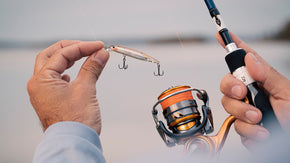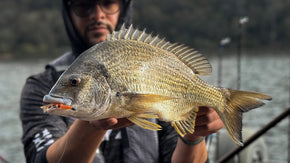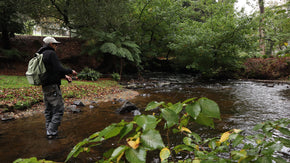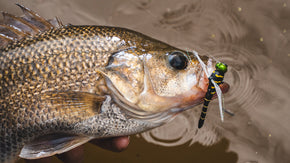Posted 02th April 2025
How to catch longtail tuna: a complete guide


By Robert Thornton
Each year anglers in South East Queensland and Northern NSW await the seasonal run of longtail tuna. These warmwater cousins of the mighty southern bluefin tuna certainly hold their own in terms of fighting ability and as a table fish, and as such are highly sought in the tropics and sub-tropics.
Like any migratory pelagic species, a good degree of knowledge and preparation are keys to success. To make things interesting, though, they do exhibit behaviours considered unusual in the tuna world. These unique characteristics endear them to inshore sport and fly fishers rather than the offshore big-game crews usually associated with tuna.
In this blog we will look at longtail tuna as a species, explore some of their peculiar habits and use this as a guide to get you onto some of these amazing sportfish!
Why the long tail?
Longtail tuna, commonly known as northern bluefin tuna, are found throughout the Indo-West Pacific – basically, throughout the Indian Ocean including along east coast of Africa and the bottom of the Asian continent, across Australia’s north coast and down much of the east and west coasts, and out into the western half of the Pacific Ocean. Despite their smaller growth potential (reaching about 40kg) compared to their southern and Atlantic counterparts, they make up for it with unique characteristics that appeal to sport anglers.
Longtails, like most tunas, migrate via offshore currents throughout the season in accordance with their spawning and feeding instincts. What’s of particular interest to anglers is their tendency to venture into sheltered bays, sounds, harbours, straits and sometimes even rivers! This may have to do with their wide-ranging diet, which includes baitfish (anchovies, sardines etc), cephalopods (squid, cuttlefish, octopus), crustaceans (prawns, crabs) plus other invertebrates, and even other pelagic species like small mackerel and bonito.
Each year between about February and September, schools of these fish flood into the inshore waters of South East QLD and Northern NSW. Their surface feeding displays in relatively shallow water (sometimes as shallow as a metre of water!) necessitate more ‘finesse’ techniques. Spinning with lures or flyfishing are more popular and effective than traditional methods like trolling with game tackle.
Spending so much of their lives inshore puts them at risk of overfishing, however in Australia they cannot be targeted by commercial fisheries, making them available to recreational fishers only. Even so, longies still feel angling pressure and are well-known for their skittish nature, with the hyper-vigilance of a bream and the sharp-eyed scrutiny of a trout. Longtails are certainly no pushover, but it's this added degree of difficulty, along with their line-peeling antics and restaurant quality meat, that make them such a highly sought inshore game fish.

Where can I find them?
Longtail tuna can be found in inshore and offshore waters year-round in tropical latitudes, however from Hervey Bay in QLD to about Sydney in NSW, they are considered a seasonal catch. They tend to spend less time in cooler waters further south but can be caught in varying numbers for most of the year in the mid latitudes.
Fish in SE QLD and Northern NSW often spend the cooler months feeding in sun warmed inshore waters, with Moreton Bay, Hervey Bay, the Great Sandy Straits and a handful of headlands and break walls regularly harbouring longtails during this time.
Though they regularly come within reach of small boat, kayak and even land-based anglers, their transitory feeding behaviour means a lot of time can be spent waiting for an opportunity or zooming around for nothing.
For boat and kayak anglers this can mean lots of moving around, and for those on land it can mean staking out a good location for hours before any longtails come to the party.
The most productive feeding zones tend to have lots of current. As for depth, this can vary a lot. Though deep water is not necessary for feeding longtails, they don’t usually stray far from main channels and shipping lanes, as this is how they travel. Sticking to these deeper thoroughfares is a good way to scout out an area, but don’t discount any adjacent flats, shoals, reefs and other adjoining shallow water features.
Longtail lessons
If you want to know how to catch longtail tuna, it helps to know what they like, and what they don’t like. For starters, bright, sunny days with little current or wind to break up the water’s surface are the trickiest days to stalk these fish. Such conditions make spotting feeding fish from a distance much easier, but they are not as conducive for sneaking up on skittish fish. Most fish feel more exposed in these conditions, and longtails are no different.
Dull days with plenty of current, on the other hand, give the angler some cover to work with. Spotting a ‘bust-up’ can be challenging, especially when things like rain, wind chop or fog come into play, but once a school is found it’s far easier to approach them without shutting them down.
As for the approach, there’s a few ways to do it. A commonly used method is to blast in with the boat and fire a few casts before they disappear. This tactic can sometimes work, but in pressured fisheries like Moreton Bay they’re more likely to dive before you can even get close enough for a cast.
Another way is to slowly approach the school with the engine barely in gear. This method can be successful, however given that longies like to move around a lot while feeding, you may just end up having to constantly change course and never actually get any closer to the fish. If you’re doing this with a petrol motor the engine should always be left on, as cutting it suddenly will spook them.
The last and arguably most productive way is to get them to come to you. Those fishing land-based or in a kayak often have no choice but to use this method. Once a feeding school is located, you can be almost guaranteed that even if they do stop busting up, they seldom move far and will most likely pop up again somewhere nearby. Birds are a great tool for anticipating the next bust up, and putting yourself in the path of low flying sea birds like gannets, terns and gulls can lead to success. Sometimes even a speculatory cast just ahead of their flight path can result in a hook up!
If they are feeding consistently but you don’t want to risk driving over and spooking them, it’s possible to position yourself so they come to you. Longtails tend to feed into the current, pinning the bait to the surface and pushing them against the current to keep them balled up. In low flow areas, they will usually feed into the wind instead. Getting your boat or kayak up current of the chaos, the longtails should move slowly in your direction while you drift with the flow toward the longtails. Once in range, you should be able to fire in a few casts before the fish even know you’re there! This technique can take time to master, and sometimes you can spend more time watching and waiting instead of actually fishing, but longtails are a fish that reward stealth and patience.

Loading up for longies
Tackle for this pursuit needs to be up to the task, as longtails – like any tuna – exert a heavy load on tackle with their blistering runs, direction changes and the infamous repetative ‘tuna circles’ under the boat toward the end of the fight.
In the boat, a spin rod set up between 7 and 8ft long is ideal, with anything in the PE 3-6 bracket suitable for longtails. The Saltist or Saltiga LC rod ranges are worth checking out for boat and kayak anglers.
Longer rods between 9 and 12ft are necessary if fishing off breakwalls, headlands, jetties or other land-based vantages. Those confined to the shore will find multiple options in the Seabass and Saltiga Surf ranges.
These rods need to be matched with heavy-duty, saltwater spec reels like the Saltist MQ or recently released 25 Saltiga in 8000-14000 sizes.
Good-quality braided line is an absolute must not only for casting distance, but also for the capacity they offer as well. You’ll need at least 300m of braid – and it certainly doesn’t hurt to have more! A 12-strand casting braid like Saltiga 12x Muscle PE is a choice pick for your longtail setup, as it’s strong, thin in diameter, and can be purchased in 300 or 400m rolls!
Good longtail hunters carry a decent range of lures, as ‘matching the hatch’ can really make or break a session. To imitate prey like prawns, anchovies, hardiheads and so on, the OT Jig, Saltiga Over There 80S, Sawarash, Bait Junkie 5” Jerkshad and 5” Prawn offer a mix of profiles, colours, speeds and actions. If you come across longtails chasing bigger forage like gar, slimy mackerel, bonito or flying fish, the Bait Junkie 10” Gar, 7” Jerkshad and Saltiga Rough Ride should have you covered.
Go long!
Longtails aren’t just any old tuna, they’re a sportfishing connoisseurs’ dream! These incredible fish fight hard, taste great and present challenges that make landing one all the more rewarding. You don’t even need a boat to chase them!
If you live within the natural range of these fish, I strongly recommend you see what all the fuss is about!
















